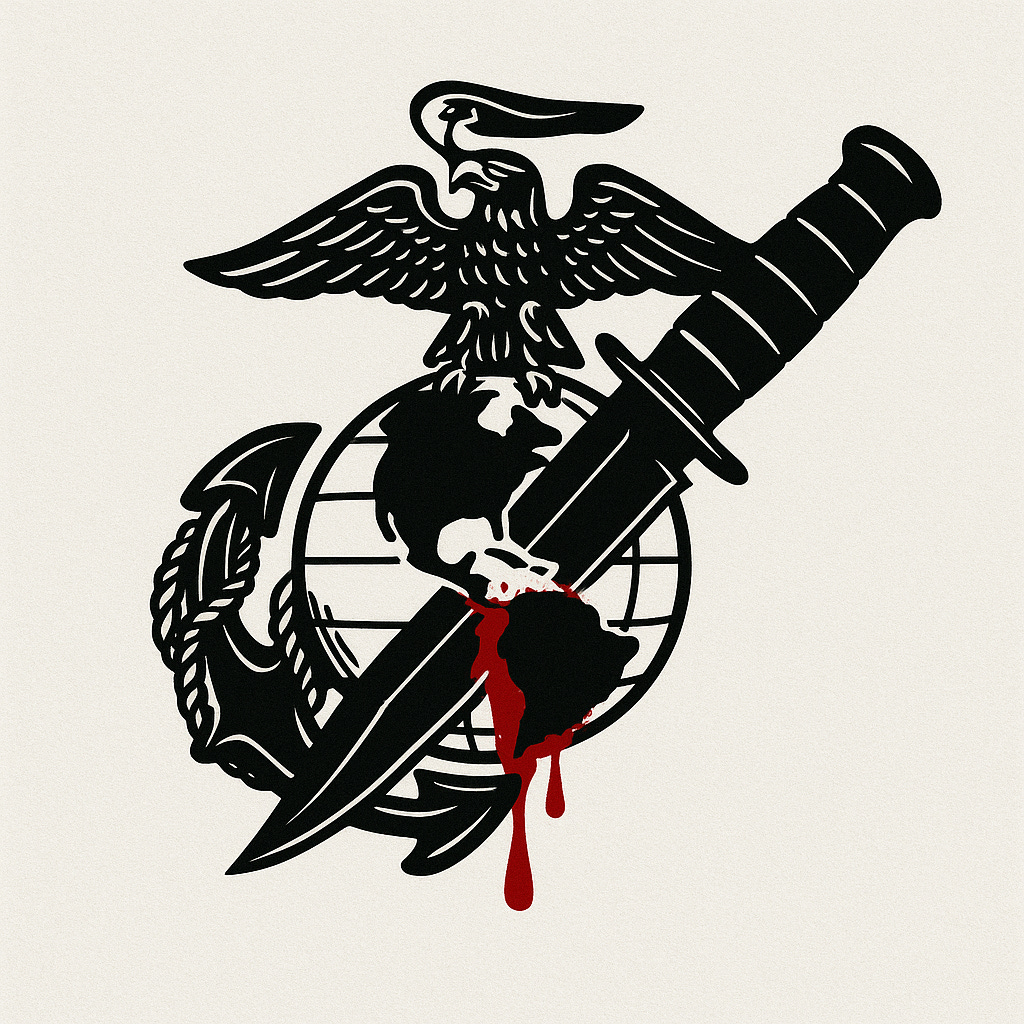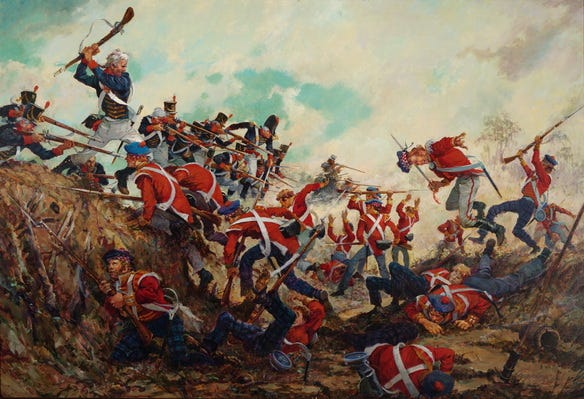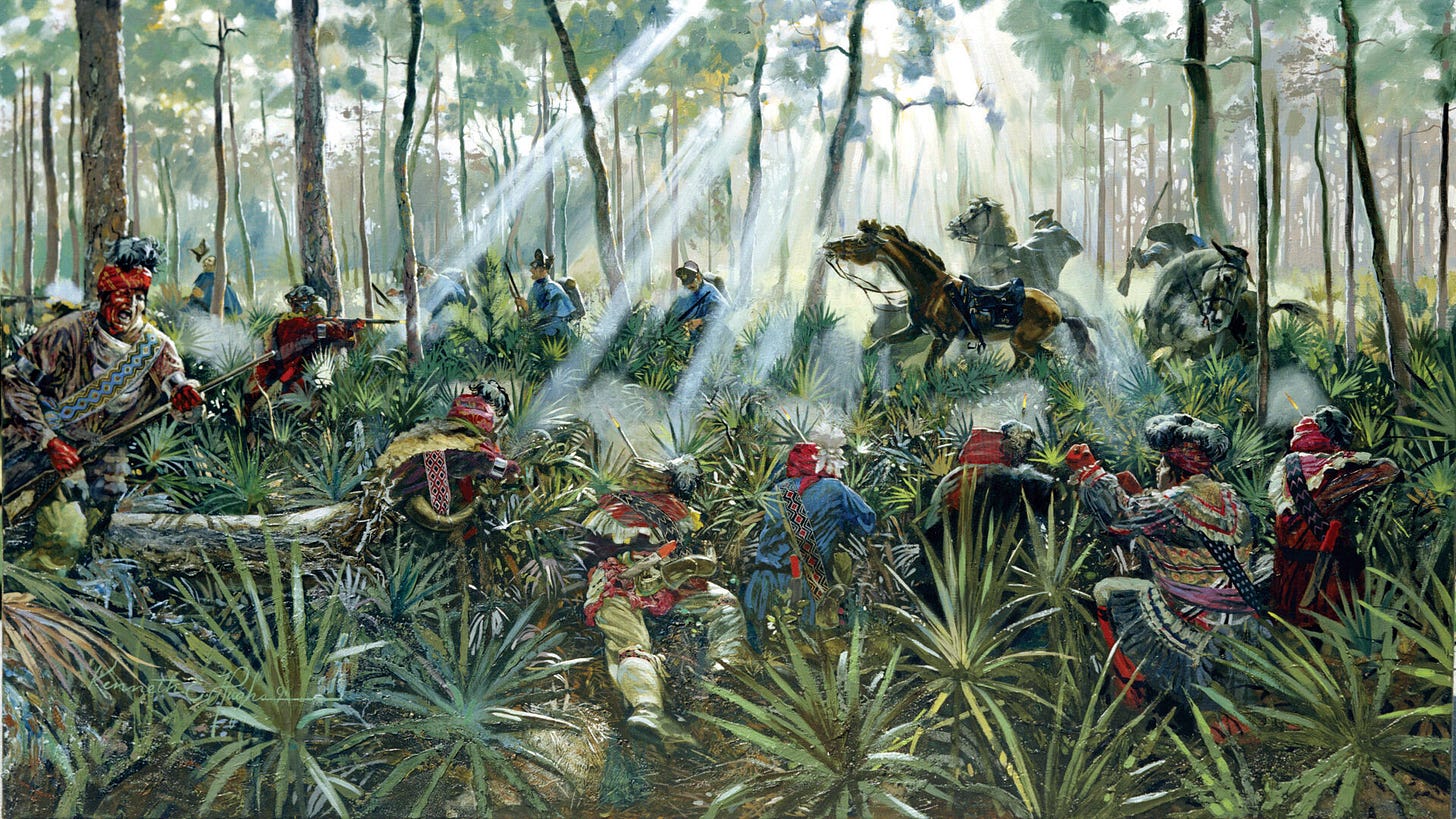Kill the Corps II
Andrew Jackson turns Blue Falcon
This is part II in the Kill The Corps series. Part I, which explains the series, is here. AI (Chat GPT) was used to create the image above but not to write the text.
The first attempt to disband the Marine Corps occurred during the administration of President Andrew Jackson. Jackson proposed that the Army absorb the Marine Corps. Jackson’s request was driven in part by accusations of corruption in the service and by Jackson’s isolationism. Service advocacy directed at both President Jackson and Congress forestalled the attempt.
But the story of Andrew Jackson and the Marine Corps began much earlier. In 1814.
Marines at the Battle of New Orleans1
Among the many other things forgotten about the War of 1812, besides almost everything else about the war except for the destruction of Washington, D.C. and the Star-Spangled Banner, is that Marines fought at the Battle of New Orleans. The battle is fascinating even if you ignore the triumphalism; it featured a large number of factions present in the young United States all coming together to introduce the British to the wonders of a preplanned combined arms defense. These include regular army forces, state militia forces from Tennessee, Kentucky, Louisiana, New Orleans city militia, local militias consisting of free men of color, a naval battalion, a Choctaw Native American militia, and even some local pirates. One of those myriad factions was a small number of Marines stationed at New Orleans under Major Daniel Carmick. It was a true melting pot of a battle and a proof of how multi-cultural the young United States truly was, despite modern attempts to erase this past.
The coming battle wasn’t Major Carmick’s first fight. As a captain during the Quasi War, Carmick had participated in a Trojan Horse style night raid at Puerto Plata Harbor. In command at New Orleans since 1809, Carmick and his unit had recently participated in an attack against Jean LaFitte’s pirate stronghold south of New Orleans in the Barataria Bayou. LaFitte’s pirates, known as Baratarians, would soon be fighting alongside the Marines instead of against them.
As the British approach New Orleans, around 35 Marines fighting from the ships participated in the Battle of Lake Borgne. It was an attempt at sea denial (or at least lake denial) to prevent the Royal Navy from accessing the littoral regions they needed to attack New Orleans itself. Royal Marines formed part of the attacking force, marking the New Orleans campaign as one of the few times U.S. and Royal Marines fought each other.
Meanwhile, Jackson had arrived and taken overall command of New Orleans. He put Major Carmick in command of a battalion of volunteers. That battalion and the Marines- now under the command of Marine 1st Lieutenant Francis Barbin de Bellevue, a Creole2- participated in a night attack against the British vanguard on 23 December 1814, catching the British by surprise and scattering the vanguard forces.
During the first British attack on Jackson’s defensive line on 28 December, the Marines under Bellevue held the right flank and Carmick commanded his volunteer battalion in the center. It was there that Carmick was struck by a Congreve rocket and grievously wounded.
During the main British attack on 8 January 1815, Bellevue’s Marines were still holding Jackson’s right flank when it is attacked by light infantry units from the British 7th Fusiliers, the 43 Monmouth Regiment, and the 93rd Sutherland Highlanders. This attack is intended to support the main British attack against the American center by turning the flank. Marines manning rifles and cannon brought ashore from Navy ships are among the troops that hold the line.
Major Carmick remained in poor health until dying, possibly of complications from his wounds, on 6 November 1816. Carmick and Bellevue clashed after the battle and Bellevue was court martialed, as indicated in this letter from Bellevue to then President James Madison. Bellevue deserves a post of his own if I’m ever able to piece together his full story.
President Jackson
Although stymied in his 1824 presidential campaign, Jackson won the presidency outright in 1828. In his very first message to Congress he recommended that the Marine Corps be absorbed by the Army.
I would also recommend that the Marine Corps be merged in the artillery or infantry, as the best mode of curing the many defects in its organization. But little exceeding in number any of the regiments of infantry, that corps has, besides its lieutenant-colonel commandant, five brevet lieutenant-colonels, who receive the full pay and emoluments of their brevet rank, without rendering proportionate service. Details for marine service could as well be made from the artillery or infantry, there being no peculiar training requisite for it.
This was the whole of his official argument, but the “many defects” he references includes corruption especially after the disastrous commandancy of Anthony Gale.
After Gale’s flameout, President James Monroe turned to then Lieutenant Colonel Archibald Henderson, now known as the “Grand Old Man of the Marine Corps” since he served as acting or confirmed Commandant from 1818 until his death in 1859, a little over 38 years. Legend has it that he tried to leave the Commandant’s House to his heirs in his will, having forgotten that they were government-owned since he had lived in them for so long.
Archibald Henderson presides over the Marine Corps when it is at its smallest point but also extremely active: Marines are in action in Haiti, the Falkland Islands, Sumatra, fighting pirates throughout the Caribbean, fighting fires (literally fires, not engaging in fire fights) in Boston, New York, and DC, and even putting down a prison riot in Massachusetts.
From Jackson’s perspective, however, the Marine Corps is a bother. It falls under Army regulations when ashore but Navy regulations at sea, causing constant friction in disciplinary matters. There are also irregularities in the pay and quartermaster departments, which had only existed for the Marine Corps since 1817. Unlike the Corps of today, Archibald Henderson’s was not passing an audit.
Still, Jackson’s recommendation caught the Marine Corps by surprise.
The Grand Old Man’s Defense
Archibald Henderson, not yet as old as his eventual nickname implies, sprang into action. Henderson constantly advocates behind the scenes to maintain the Marine Corps as its own service, even to the Secretary of the Navy John Branch who had first indicted the Marines for pay and supply irregularities.
Both the Senate and House Naval Affairs committees held hearings on Jackson’s recommendation in 1830, but neither was interested in acting on it. Then Secretary Branch tries again in 1831, making the same recommendation as Jackson in hisown 1831 report to Congress.
These attempts, ironically, lead to the An Act for the Better Organization of the Marine Corps, passed by Congress in 1834. This act fixed the problem of regulation, placing the Corps under Navy regulation both ashore and afloat, increased its size to 63 officers and 1,224 enlisted (its largest point so far), and promoted Archibald Henderson to full colonel. Not too shabby a reward for defending the service.
Jackson signed the bill.
The Seminole Wars
Jackson’s gratitude for services rendered during the Battle of New Orleans was not just denied to Marines but to Native Americans as well. By 1836, the Army is struggling in wars against Creek and Seminole efforts to resist deportation from Florida, Georgia, and Alabama. In 1835, two Army companies under the command of Major Francis L. Dade were ambushed by Seminole warriors. Only three soldiers survived, and the Dade Massacre became a national scandal that was only pushed out of the news by the Battle of the Alamo the following year. Henderson offers two battalions to Jackson which he accepts and orders them south to support the Army. Henderson personally leads the 38 officers and 424 enlisted Marines- over half the Marine Corps.
In the Florida everglades, even more Marines are landed from Navy ships from the West India Squadron. These Marines and sailors, dubbed the “Mosquito Fleet,” performed river patrols and actions using small craft, cutters, and canoes. By late 1836, the Marines are augmented by Creek militias (led by Marine officers) from Alabama who had joined the fight against the Seminoles. In 1837 the overall Army commander, Major General T. H. Jesup, gives Henderson command of one of two Army brigades. Henderson’s brigade included regular Army forces, Georgia volunteers, the Creek volunteers, and the Marine battalions. In 1838, the Marines return to Washington with Henderson wearing brevet brigadier general rank for success as a brigade commander, the first general officer in Marine Corps history.3
Conclusion
While certainly not the most glorious war in the Marine Corps history given what Jackson was doing to the Native Americans, the Seminole War at least proved Congress’ prescience in maintaining its existence and fixing its hazy legal status. Jackson’s attempt to disband the Marine Corps, despite critical service rendered by the Marine Corps under his command during the New Orleans campaign, proved both shortsighted and counterproductive.
But it was hardly innovation or high standards that saved the Marine Corps. Instead, it was Henderson’s energetic defense and the desires of Congress that saved the day. As usual, when the existence of the Marine Corps was threatened, they were shortly needed again.
There are multiple accounts of the Marines in the New Orleans Campaign. For this article, I’ve leaned heavily on this one because it is a relatively recent examination, but this period of Marine Corps history remains under examined in general. The Marine Corps Archives does not have many documents older than World War I.
I haven’t been able to find much on Lieutenant Bellevue other than what it is in this post. Someday I intend to get to New Orleans and do some digging. He may have been the first non-white officer in Marine Corps history but I can’t say so without confirming that he was a non-white Creole.
This account is drawn from Robert Heinl’s Soldiers of the Sea: The United States Marine Corps, 1775-1962.




Semper Fi. There is always going to be a need for a ready-to-roll expeditionary force that can move fast and hit hard. Besides, my father Gy. Sgt. of Merrill's Raiders will lead every dead Marine out of the grave to put right any attempt to disband the Corps.
The Creek sadly would get no benefit from this iteration of an already existing conflict for them when Jackson began active removals of them and others.